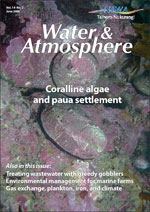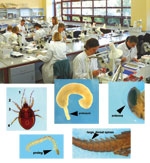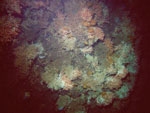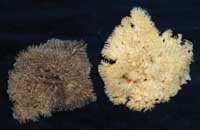PDF of this article (171 KB)

Bugged by bugs?
NIWA identification workshops
- How do I tell a damselfly from a swimming mayfly?
- What’s the difference between lateral gills and pseudopods?
Brian Smith answered these and many similar questions at the NIWA training course, 'Introduction to stream invertebrates', held in April at the University of Waikato in Hamilton.
The one-day workshop was well attended by staff from regional councils, polytechs, environmental consultancies, and Biosecurity NZ. It was pitched for beginners wishing to identify freshwater invertebrates and those who wanted to brush up on their ID skills. It also provided an ideal introduction to NIWA’s more advanced identification courses, such as those for people who need to identify invertebrates to a level required for stream biomonitoring (for example, using the Macroinvertebrate Community Index).

Participants used identification guides developed specifically for the workshop following the proven 'quick-guide' format. This format uses a flow diagram for identifying specimens that makes the guides both user-friendly and efficient. They highlight the points of difference in size, colour, and structure that distinguish one taxon from another. The guides covered a range of commonly encountered invertebrate groups, from freshwater insects to Mollusca (snails, clams, and the like). Participants worked with six quick guides and a reference collection of over 500 labelled specimens.
For further information, contact: Brian Smith, 0-7-856 1756, [email protected]
The DAWG gets down to business


CenSeam, an international Census of Marine Life project, held its first Data Analysis Working Group (DAWG) meeting in February. Coordinated by NIWA scientist Ashley Rowden, and comprising a membership from five countries, the DAWG’s aim is to evaluate and review available seamount data and data-analysis techniques. Overall, the DAWG’s priority is to identify missing data, at a global scale, to help guide future sampling efforts. With this in mind, CenSeam is planning voyages to the Indian Ocean as well as some previously unvisited areas of the Pacific.
The impacts of human activities on the high seas, and in particular the effects of deepwater fishing on seamounts, have become the focus of considerable discussion. The DAWG has chosen to analyse a restricted group of fauna, namely corals, to provide detailed information on their likely vulnerability to deepwater trawling on seamounts beyond areas of national jurisdiction. The work will ultimately inform decision-making related to the conservation of biodiversity and the management of seamount resources on the high seas.
The workshop was funded by the Netherlands' Department of Nature, Ministry of Agriculture, Nature and Food Quality, whose support is gratefully acknowledged. A report will be published by CBD, UNESCO/IOC, and UNEP in August.
For more about CenSeam, see Water & Atmosphere 14(1): 9.
For further information, contact: Dr Mireille Consalvey, 0-4-386 0853, [email protected]
